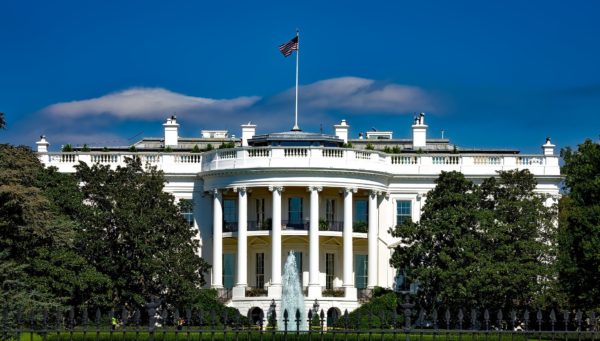On Earth Day 2021, President Biden set a new target for the United States to achieve a 50-52% reduction from 2005 levels in economy-wide net greenhouse gas pollution by 2030.
The announcement was made during a two-day international Leaders Summit on Climate that Biden organized in an effort to challenge the world on addressing climate change.
Gregory Wetstone, president and CEO of the American Council on Renewable Energy, said that the Nationally Determined Contribution submitted by the Biden administration “sends a clear message that the United States is ready to embrace the economic transformation necessary to tackle the climate crisis.”

Image: Pixabay
As part of the administration’s ambition to halve U.S. emissions, it set a goal to reach 100% carbon pollution-free electricity by 2035. It aims to do that by deploying a range of generating resources, transmission, and energy storage, and by retrofitting fossil-fueled power plants with carbon capture technology. Nuclear power is also part of the administration’s mix of technology options.
(Like our solar coverage? Subscribe to our daily newsletter.)
Another goal is to pursue efficiency upgrades and electrification in buildings. This would be done through wider use of heat pumps and induction stoves, and adoption of modern energy codes for new buildings. The U.S. will also invest in new technologies to reduce emissions associated with construction, including for high-performance electrified buildings.
In the industrial sector, the Biden administration pointed to possible carbon reductions through carbon capture as well as new sources of hydrogen—produced from renewable energy, nuclear energy, or waste—to power industrial facilities. It said the government can use its procurement power to support early markets for these low- and zero-carbon industrial goods.
The administration also said that the U.S. will invest in innovation to improve and broaden the set of solutions as a “critical complement to deploying the affordable, reliable, and resilient clean technologies and infrastructure available today.”
Work starts on BTA solar project
Canadian Solar said that its Recurrent Energy unit has started work on the 100 MW Sunflower Solar Project in western Mississippi. To support construction, Recurrent closed debt financing totaling more than $146 million with Norddeutsche Landesbank and Rabobank.
Sunflower is being built under a Build Transfer Agreement. Recurrent signed a BTA with Entergy Mississippi in 2018 designating that the utility will own the Sunflower solar project when it reaches commercial operation in early 2022. The BTA was approved by state utility regulators in April 2020. The project will use Canadian Solar’s high-efficiency modules.
Tesla solar panels and Powerwall batteries
News reports said that Tesla solar panels and roof will only be sold together with its Powerwall battery. Solar power from these panels will feed exclusively to Powerwall, CEO Elon Musk reportedly said in a series of tweets.

Image: Wikimedia Commons/Duncan Hall
His comments followed a Twitter exchange with Ark Investment Management’s Director of Research Brett Winton who said his solar installed by Tesla in January “hasn’t generated a single watt-hour” and that he was waiting for his utility to approve the connection. Musk said during Tesla’s fourth-quarter earnings call in January that the company was focusing on further integrating Powerwall with its solar division. The Twitter announcement would seem to move that idea forward.
Another FPL solar plans is under way
A fourth Florida Power & Light Co. solar energy center begins construction in May, this time on the 74.5 MW Grove Solar Energy Center near Vero Beach on Florida’s east coast. Work is expected to be completed this summer. FPL currently has 37 solar energy centers in operation. The company plans to have more than 100 solar energy centers across Florida by 2030.
Atlas signs BESS agreement with Hitachi ABB
Miami-based Atlas Renewable Energy signed a Collaboration Agreement with Hitachi ABB Power Grids to jointly develop and execute battery energy storage systems (BESS) at a utility scale level for Atlas’ renewable projects.
The agreement will allow Hitachi ABB Power Grids to take part in developing and deploying BESS in new projects across Latin America. Hitachi ABB Power Grids will be invited to participate in tenders launched by Atlas Renewable Energy for the Engineering Package of the projects.
The main objective behind this agreement is to ensure that BESS can be successfully integrated into the design of new projects during the early development stage.
Two years ago, Atlas announced that it would be one of the first generators in Latin America to roll-out the TrueCapture system developed by Nextracker. Through the use of TrueCapture, the company’s solar plants tracking system has been optimized to the modular level resulting in an increase of the plants’ overall performance and efficiency.
Atlas Renewable Energy has also been one of the first developers to test bifacial modules and to introduce this technology on large scale, with around 1 GW of capacity being generated with this panel technology.
Atlas has around 2.2 GW of contracted projects in development, construction or operational stages, and aims to expand that amount by an additional 4 GW.
This content is protected by copyright and may not be reused. If you want to cooperate with us and would like to reuse some of our content, please contact: editors@pv-magazine.com.









“News reports said that Tesla solar panels and roof will only be sold together with its Powerwall battery. Solar power from these panels will feed exclusively to Powerwall, CEO Elon Musk reportedly said in a series of tweets.”
…
My Tesla Solar Roof is producing a lot of power and they sold it to ME without a Powerwall. The Nem2 Net metering from PG&E and East Bay Energy has a lot of incentive to NOT get a “power wall” with the system. Sending power to the Powerwall only and letting it decide to put the electricity into the house or send it to the utility is great for “time of day” metering or short term power outages power outages, But, the added cost would not be recovered over the life of the battery. Not everybody will go to the extra expense for the “Solar Roof” if they are forced to buy a Powerwall on top of it. My neighbor wanted to get a roof, like mine, but was told he could only get it with a Powerwall and it made the job too expensive and he cancelled the solar roof installation.